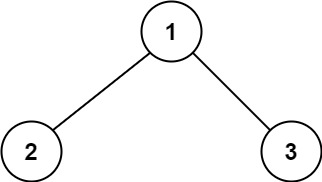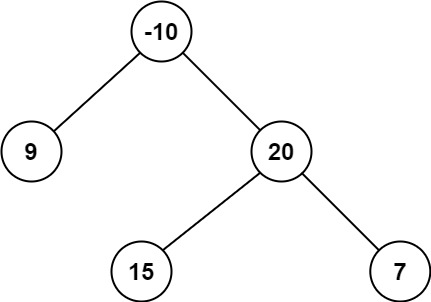#124 - Binary Tree Maximum Path Sum
Binary Tree Maximum Path Sum
- Difficulty: Hard
- Topics: Dynamic Programming, Tree, Depth-First Search, Binary Tree
- Link: https://leetcode.com/problems/binary-tree-maximum-path-sum/
Problem Description
A path in a binary tree is a sequence of nodes where each pair of adjacent nodes in the sequence has an edge connecting them. A node can only appear in the sequence at most once. Note that the path does not need to pass through the root.
The path sum of a path is the sum of the node’s values in the path.
Given the root of a binary tree, return the maximum path sum of any non-empty path.
Example 1:

Input: root = [1,2,3]
Output: 6
Explanation: The optimal path is 2 -> 1 -> 3 with a path sum of 2 + 1 + 3 = 6.
Example 2:

Input: root = [-10,9,20,null,null,15,7]
Output: 42
Explanation: The optimal path is 15 -> 20 -> 7 with a path sum of 15 + 20 + 7 = 42.
Constraints:
- The number of nodes in the tree is in the range
[1, 3 * 104]. -1000 <= Node.val <= 1000
Solution
1. Problem Deconstruction
Technical Definition:
Given a binary tree where each node has an integer value (positive or negative), compute the maximum possible sum of any non-empty path. A path is defined as a sequence of distinct nodes connected by edges where adjacent nodes share a parent-child relationship. The path need not include the root and can start/end at any node. The solution must efficiently handle large trees (up to 30,000 nodes) and negative values.
Beginner Explanation:
Imagine a family tree where each person has a value (like money they contribute). Your task is to find the most valuable connected group of people. The group must form an unbroken chain (parent-child-grandchild, etc.), but you can start and end anywhere. The challenge is to compute the highest possible sum of values in such a chain.
Mathematical Formulation:
Let ( T ) be a binary tree with nodes ( v_1, v_2, \ldots, v_n ), each with value ( \text{val}(v_i) ). A path ( P = (v_{k_1}, v_{k_2}, \ldots, v_{k_m}) ) satisfies:
- Adjacency: ( (v_{k_j}, v_{k_{j+1}}) ) share an edge ( \forall j ).
- Uniqueness: ( v_{k_j} ) appears at most once.
The path sum is ( \sum_{j=1}^{m} \text{val}(v_{k_j}) ).
Objective:
[ \max_{\text{non-empty } P} \left( \sum_{v \in P} \text{val}(v) \right) ]
Constraint Analysis:
- Node count ( \in [1, 3 \times 10^4] ):
- Limits solutions to ( O(n) ) or ( O(n \log n) ). ( O(n^2) ) is infeasible (90M operations worst-case).
- Implies skewed trees → recursion depth up to 30k (risky in Python). Requires iterative DFS or tail recursion optimization.
- Node values ( \in [-1000, 1000] ):
- Negative values force handling of “lossy” segments. Single-node paths may dominate if all values are negative.
- Edge case: Entirely negative trees → solution is (\max(\text{node values})).
- Paths may bridge positive subtrees via negative nodes if net gain is positive.
2. Intuition Scaffolding
Real-World Metaphor:
A toll road network where cities (nodes) have tolls (values). Find the most profitable contiguous drive (path) without revisiting cities. Negative tolls force detour decisions.
Gaming Analogy:
In an RPG skill tree, each node grants a bonus/penalty. Activate a connected path for cumulative effects. Maximize bonus while navigating penalties.
Math Analogy:
Tree-adapted Kadane’s algorithm. At each node, compute max “straight” path (linear chain) and “bent” path (forking through the node). Global max aggregates local decisions.
Common Pitfalls:
- Root Fixation: Assuming the path must include the root (counter: Example 2).
- Negative Mishandling: Clamping gains to 0 prematurely (may discard single negative nodes).
- Suboptimal Branching: Taking both children naively breaks path contiguity for ancestors.
- Initialization Errors: Setting global max to 0 (fails for all-negative trees).
- Overlooked Forked Paths: Missing paths spanning left and right subtrees (e.g., 15→20→7 in Example 2).
3. Approach Encyclopedia
Brute Force (Theoretical):
- Idea: For each node, compute all downward paths. For ( v_i ), traverse subtree to find max path through ( v_i ).
- Pseudocode:
def brute_force(root): def dfs(node, current_sum): nonlocal global_max if not node: return current_sum += node.val global_max = max(global_max, current_sum) dfs(node.left, current_sum) dfs(node.right, current_sum) current_sum -= node.val # Backtrack global_max = -inf for each node in tree: # O(n) nodes dfs(node, 0) # O(n) per node → O(n²) return global_max - Complexity: Time ( O(n^2) ), Space ( O(h) ).
Derivation: ( n ) nodes, each triggering a DFS of ( O(\text{subtree size}) ). Worst-case subtree size ( O(n) ) → ( \sum_{i=1}^{n} O(n) = O(n^2) ). - Visualization (Skewed Tree):
Root: 1 │ └─2 │ └─3 │ └─... → 30k nodes Path calculations per node: 30k, 29.9k, ... → ~450M ops (infeasible).
Optimal Approach (Recursive DFS):
- Idea: Postorder traversal. At each node:
- Compute max straight path gains from left/right children (negative → 0).
- Update global max with path through node + both children.
- Return max straight path (node + max child gain) for parent reuse.
- Pseudocode:
def maxPathSum(root): global_max = -inf def max_gain(node): nonlocal global_max if not node: return 0 left_gain = max(0, max_gain(node.left)) # Skip if negative right_gain = max(0, max_gain(node.right)) # Update global max for paths using node as root global_max = max(global_max, node.val + left_gain + right_gain) # Return max straight path for parent return node.val + max(left_gain, right_gain) max_gain(root) return global_max - Complexity: Time ( O(n) ), Space ( O(h) ).
Derivation: Each node visited once. Recursion depth = tree height ( h ). Worst-case ( h = n ) (skewed tree). - Visualization (Example 2):

Steps: Node 9: gain=9 → global_max=9 Node 15: gain=15 → global_max=15 Node 7: gain=7 → global_max=15 Node 20: left_gain=15, right_gain=7 → candidate=42 → global_max=42 Root: left_gain=9, right_gain=35 → candidate=34 → global_max=42
Iterative DFS (For Deep Trees):
- Idea: Simulate recursion with stack. Track node state (0: unprocessed, 1: left done, 2: both done). Store gains in a dict.
- Pseudocode:
def maxPathSum_iterative(root): if not root: return 0 stack = [(root, 0)] # (node, state) gains = {None: 0} # Handle null children global_max = -inf while stack: node, state = stack.pop() if state == 0: # Unprocessed: push left child stack.append((node, 1)) if node.left: stack.append((node.left, 0)) elif state == 1: # Left done: push right stack.append((node, 2)) if node.right: stack.append((node.right, 0)) else: # Both done: compute gains left_gain = max(0, gains.get(node.left, 0)) right_gain = max(0, gains.get(node.right, 0)) candidate = node.val + left_gain + right_gain global_max = max(global_max, candidate) gains[node] = node.val + max(left_gain, right_gain) return global_max - Complexity: Time ( O(n) ), Space ( O(n) ) (stack + gains dict).
4. Code Deep Dive
Optimal Solution (Recursive):
def maxPathSum(root) -> int:
global_max = float('-inf') # Initialize to -∞ for all-negative trees
def max_gain(node):
nonlocal global_max
if not node:
return 0 # Base case: null nodes contribute 0
# Recurse left/right; clamp negative gains to 0 (skip branch)
left_gain = max(0, max_gain(node.left)) # Line 7: Skip lossy subtrees
right_gain = max(0, max_gain(node.right)) # Line 8
# Path through node + both children (cannot extend to parent)
path_through_node = node.val + left_gain + right_gain # Line 10
global_max = max(global_max, path_through_node) # Line 11: Update global
# Max straight path: node + best child (for parent extension)
return node.val + max(left_gain, right_gain) # Line 13
max_gain(root) # Initiate DFS
return global_max
Line-by-Line Analysis:
- Line 2:
global_max = -inf
What: Safeguards all-negative trees.
Why: Single-node paths may be negative (e.g., [-5] → -5). - Lines 7-8:
left_gain = max(0, ...),right_gain = max(0, ...)
What: Clamp child gains to 0 if negative.
Why: Negative gains reduce path sum → skip branch. - Line 10:
node.val + left_gain + right_gain
What: Path using node + both children.
Why: Captures “bent” paths (e.g., 15→20→7 in Example 2). - Line 11: Update
global_max
What: Track best path encountered.
Why: Local paths may be globally optimal. - Line 13:
node.val + max(left_gain, right_gain)
What: Max straight path for parent reuse.
Why: Parents can extend this path (no forks).
Edge Case Handling:
- All-Negative Tree (e.g., [-3, -1, -2]):
left_gain/right_gainclamp to 0 →path_through_node = -3,global_maxupdates to -3 at root. Leaf nodes setglobal_maxto max(-1, -2, -3). - Single Node (e.g., [5]):
left_gain = right_gain = 0→path_through_node = 5→global_max = 5. - Example 2:
At node 20:left_gain=15,right_gain=7→path_through_node=42→global_max=42.
Root:path_through_node=34< 42 → no update.
5. Complexity War Room
Hardware-Aware Analysis:
- Time: ( O(n) ) → 30k nodes = 30k ops (negligible on modern CPUs).
- Space (Recursive):
- Worst-case (skewed tree): 30k stack frames.
- Frame size ≈ 128B → 30k * 128B = 3.84MB (fits in L3 cache).
- Risk: Python recursion limit (default 1k) → use
sys.setrecursionlimit(35000)or iterative DFS.
- Space (Iterative):
- Stack +
gainsdict: ( O(n) ) → 30k * 64B ≈ 1.92MB (acceptable).
- Stack +
Approach Comparison:
| Approach | Time | Space | Readability | Interview Viability |
|---|---|---|---|---|
| Brute Force | O(n²) | O(h) | ★★★☆☆ | ❌ Fails large n |
| Recursive DFS | O(n) | O(h) | ★★★★★ | ✅ (if h < 1k) |
| Iterative DFS | O(n) | O(n) | ★★★☆☆ | ✅ (always safe) |
6. Pro Mode Extras
Variants:
- Leaf-to-Leaf Max Path (GeeksforGeeks):
- Path must start/end at leaves.
- Modify: Update
global_maxonly if node has two children. - Code:
if node.left and node.right: # Only update if both children exist global_max = max(global_max, node.val + left_gain + right_gain)
- Path Sum III (LC 437):
- Count paths summing to target (not just max).
- Use prefix sums + DFS.
- Diameter of Binary Tree (LC 543):
- Maximize edge count (not sum).
- Replace
node.valwith 1, sum with edge count.
Interview Cheat Sheet:
- Key Insight: Path = max(node + best child, node + left + right).
- Complexity First: Always state time/space upfront.
- Edge Cases:
- All-negative values.
- Single node.
- Skewed trees (recursion depth).
- Verification: Test with examples + all-negative.
- If Asked: Extend to ( k ) transactions (LC 123) or cyclic graphs.